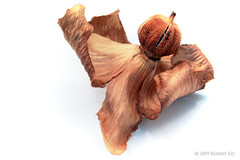
[Photo: Sarracenia ‘Leah Wilkerson’, top of hood view – from 2008]
In this “hobby”- a few of us could look back and see where it had really set foot and cemented itself into our life. For me, I have always been into plants, always into gardening. As a child I grew up with my grandparents, helping them out in the garden. The garden has always been a part of me and my life. [More on this and how I got into the carnivores later…]
That one plant that really cemented my addiction to Sarracenia and creating new hybrids was S. ‘Leah Wilkerson’. (Thanks Brooks!) This was my addiction. A truly fantastic and spectacular plant indeed. It was in December of 2006 when I first received this plant; I knew then that my addiction was forever interwoven in the fiber of my being. December 2006 – the winter of my discontent. I wanted more. I was hungry to learn so much more.
At this point in 2006, I had been growing carnivores for about oh, 2 or 3 years or so. I had a small yet rapidly growing collection at this time, mostly of plants that were pretty available. I visited a couple carnivorous plant nurseries already within the past couple years and was just getting into this carnivore thing. One of the places I visited in 2005 was Karen Oudean’s nursery in Washington State. Later on she told me that she could already see it in me and already knew that I would be in this deep. Ha! 🙂
Anyway, at this time, I had plants like those Venus fly traps, sundews, and quite a few pitcher plants. I definately was not too knowledgeable about all of the different cultivars out there, but when I saw S. ‘Leah Wilkerson’ – that REALLY did it. Floodgates opened. I remember feeling how much I wanted to know. How much I wanted to learn so much more about Sarracenia and hybridization. From this point on I began to seek out and talk more with people who have been growing, learning as much as I could. More importantly – I was learning and being inspired by their wisdom. I am forever thankful for those of you who took the time to teach and inspire me (you know who you are!)
So for me, yeah, you could say it was S. ‘Leah Wilkerson’ that really sparked the insanity.

[Photo: Sarracenia ‘Leah Wilkerson’, from 2008]
 [Photo: Sarracenia leucophylla x flava seedlings. 2 years old]
[Photo: Sarracenia leucophylla x flava seedlings. 2 years old] [Photo: Sarracenia ‘Hummer’s Okee Classic x purpurea ssp. venosa – a cross I did back in 2008]
[Photo: Sarracenia ‘Hummer’s Okee Classic x purpurea ssp. venosa – a cross I did back in 2008]



















